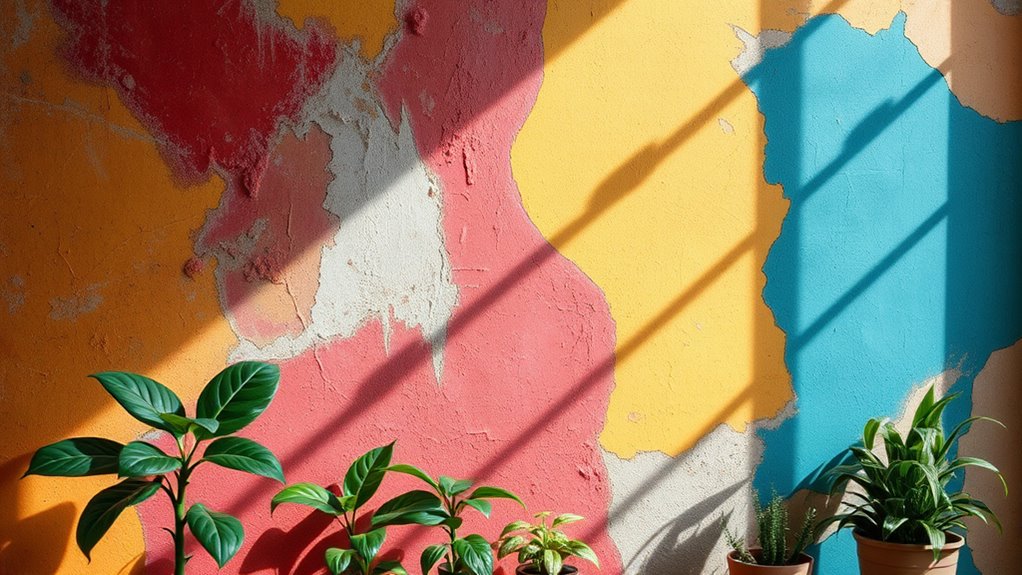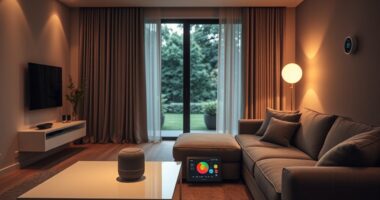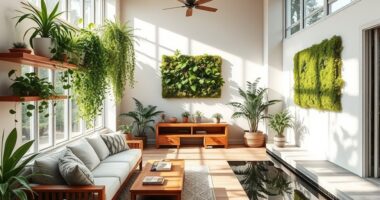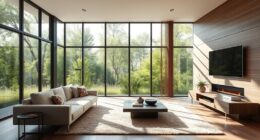To follow the textured wall trend, start by selecting materials that resonate with your style, like Venetian plaster or reclaimed wood. Consider the room size and function when choosing textures, and designate a feature wall for bold designs. Enhance the look with strategic lighting that casts shadows, highlighting the textures. Regular maintenance will keep your walls looking fresh. Keep exploring to discover tips on incorporating textured ceilings and balancing different textures for a cohesive design.
Key Takeaways
- Explore various textured wall materials like Venetian plaster, reclaimed wood, and 3D panels to find the perfect fit for your space.
- Designate a feature wall to showcase bold textures, enhancing the room’s focal point and overall aesthetic.
- Complement textured walls with strategic lighting to highlight depth and create visual interest through shadows.
- Incorporate sustainable materials and vibrant colors to stay ahead of trends while enhancing your interior design.
- Maintain textured walls with regular cleaning and inspections to ensure their beauty and longevity.
Understanding the Appeal of Textured Walls
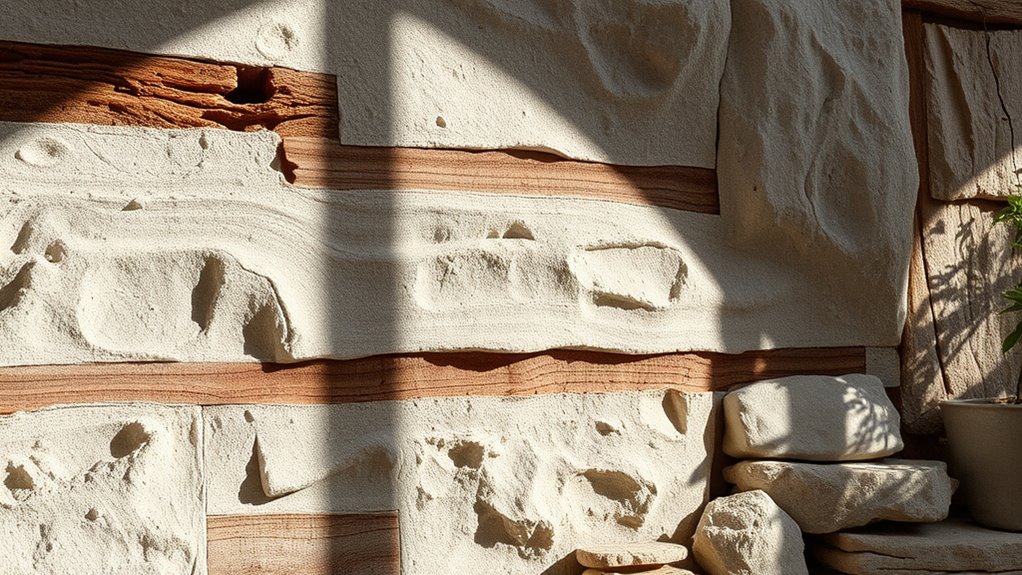
Textured walls bring a mesmerizing depth to your interiors that flat finishes simply can’t match.
Textured walls introduce captivating depth to your interiors, far surpassing the limitations of flat finishes.
When you choose textured finishes like Venetian plaster or limewash, you add depth and dimension, enhancing the overall aesthetic appeal of your space. These organic textures create a unique cloud-like effect, making each stroke contribute to your room’s design narrative.
Plus, they can conceal imperfections, making them perfect for high-traffic areas. Textured walls also improve acoustics by diffusing sound, creating a more inviting atmosphere.
As you embrace natural materials and sustainable practices, you’ll find that textured finishes cater to diverse design preferences, allowing you to evoke various moods and styles in your home. This shift towards personalized environments elevates your interior experience, making it essential to assess client needs to ensure your design aligns with their vision.
Choosing the Right Texture for Your Space
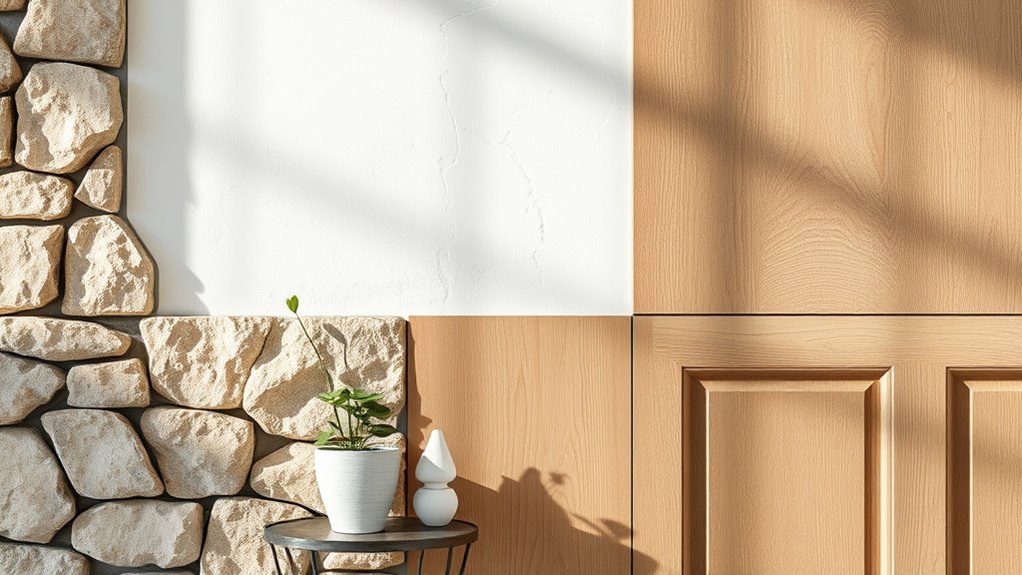
How do you decide which texture suits your space best? Start by considering the size of your room; lighter textures can keep smaller areas feeling open and airy.
Next, think about your existing color palette—choose textures that blend harmoniously or introduce complementary shades for a cohesive look.
Evaluate the function of each room, too; plush fabrics may work wonders in cozy living spaces, while sleek finishes can elevate modern kitchens.
Don’t forget to designate a feature wall to showcase a bold texture, creating a stunning focal point that draws attention.
Finally, apply textures strategically to highlight architectural details like alcoves or columns, enhancing the overall flow and design coherence in your home.
Popular Textured Wall Materials
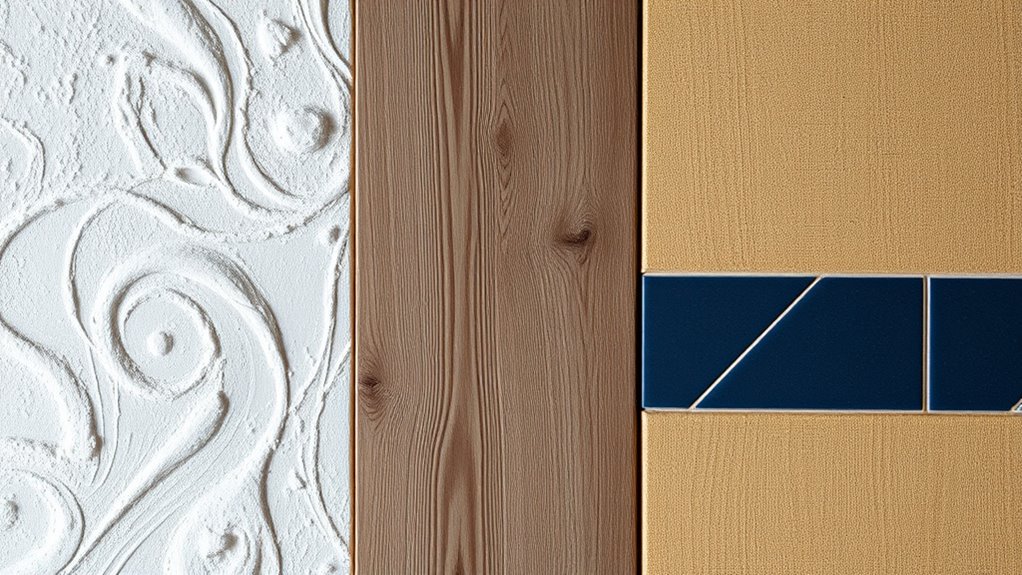
When it comes to textured walls, the materials you choose can make all the difference in creating the desired ambiance.
Popular textured treatments include Venetian plaster, which offers depth and warmth while resisting mold.
If you’re drawn to rustic or contemporary designs, reclaimed wood panels add character and a cozy feel.
For a natural vibe, woven wall coverings like grasscloth provide understated texture and come in soft neutral tones.
If you’re looking for something bold, 3D wall panels can introduce striking geometric or organic designs that captivate attention.
Finally, specialty textured paints mimic substantial materials, giving you an affordable option to achieve depth and interest without the hassle of additional wall treatments.
Tips for Creating a Focal Point With Texture
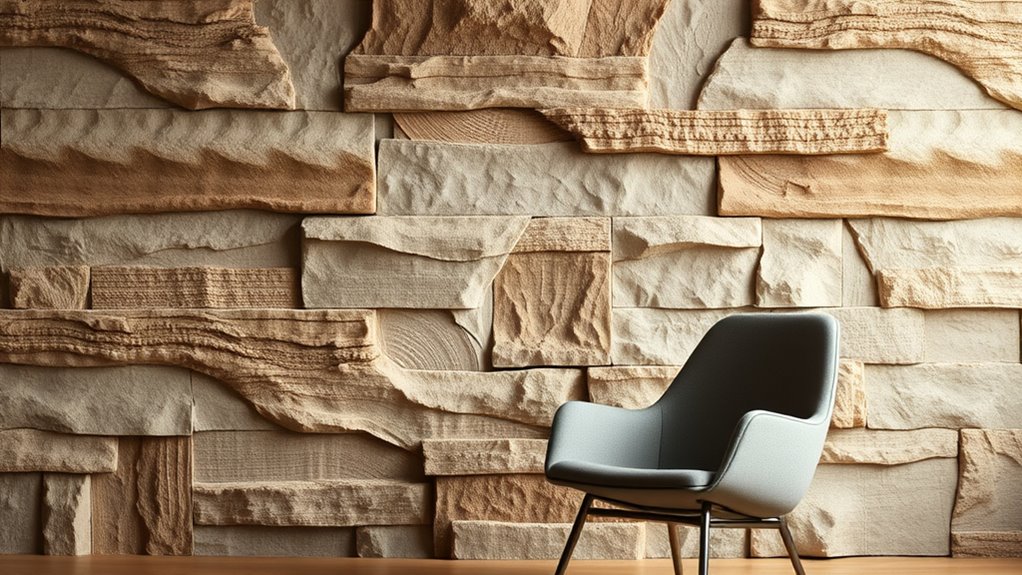
Creating a striking focal point with texture can dramatically enhance your space, drawing the eye and adding depth.
Designate a single wall as a feature wall and choose a textured treatment, like Venetian plaster or limewash, to enrich its visual appeal. Darker neutral or warm-toned plasters can introduce subtle color, enhancing the room’s ambiance without overpowering it.
Transform a single wall with textured treatments like Venetian plaster or limewash to enrich your space’s visual appeal.
Consider incorporating intricate carved designs or geometric patterns to transform the wall into an artistic canvas that captivates attention.
Pair your textured wall with complementary decor elements, such as stylish lighting or furnishings, to create a cohesive look.
Finally, use strategic lighting to highlight the textures, casting shadows that emphasize the three-dimensional quality of your new focal point. Additionally, maintaining an organized space around your textured wall can enhance the overall emotional well-being of the environment, creating a serene atmosphere that complements the focal point.
Balancing Bold and Subtle Textures
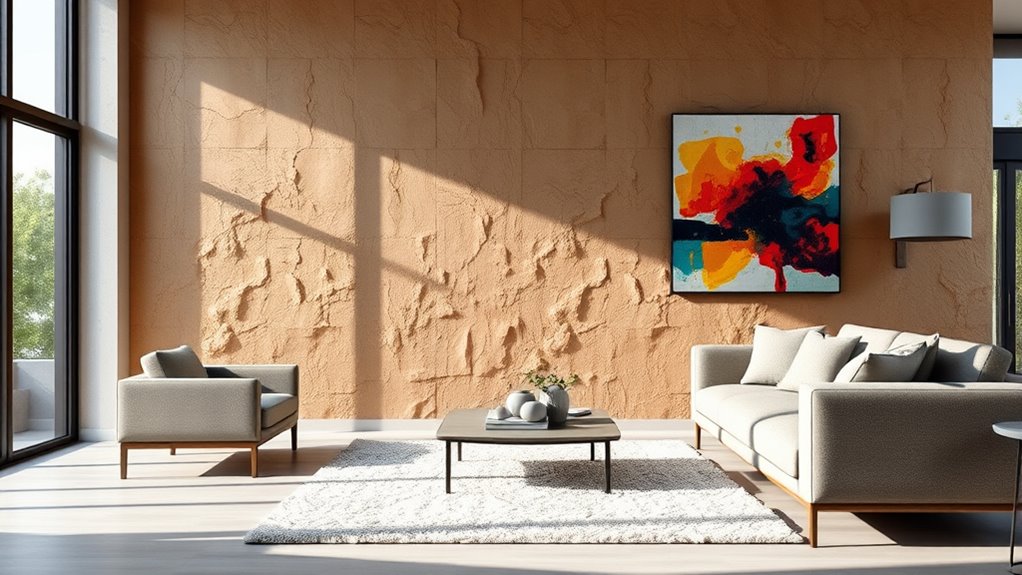
Designing with texture invites you to explore the interplay between bold and subtle elements in your space.
In smaller rooms, opt for lighter textures to keep things cozy without overwhelming the area. For harmony, align your textures with existing color palettes or introduce complementary shades that enhance your overall aesthetic.
To create visual interest, choose one feature wall with a bold texture while keeping other walls subtle. This balance allows the bold element to shine without competing for attention.
Strategically apply textures to highlight architectural features like alcoves or columns, enhancing the flow of your design.
Don’t forget to use directional lighting to accentuate your textured walls, creating dynamic shadows that elevate the tactile experience. Incorporating different materials can further enhance the visual appeal of your textured walls, adding depth and character to your space.
Incorporating Textured Ceilings
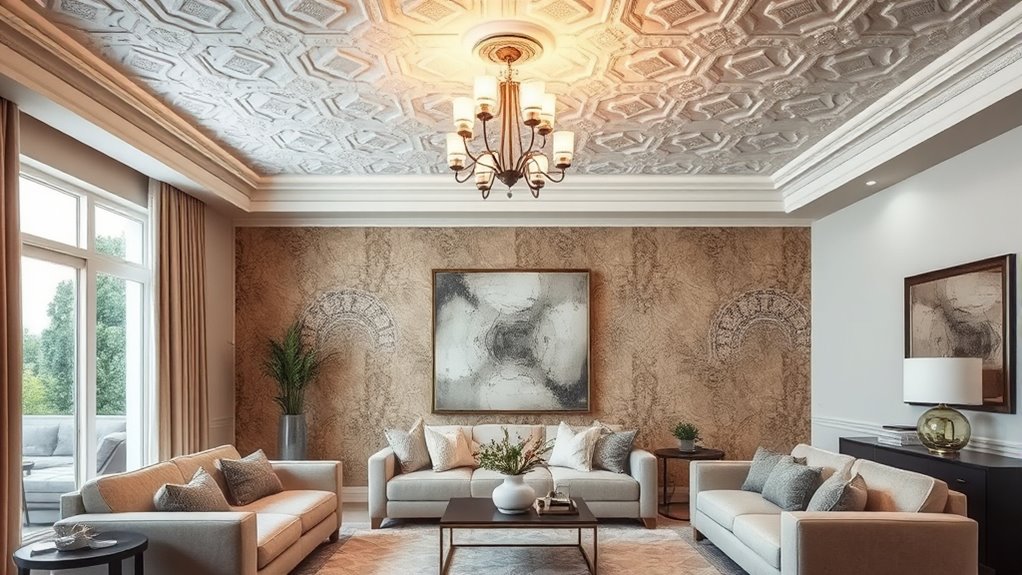
When you think about textured ceilings, coffered designs and textured beams can really elevate the drama in your space.
Using paint techniques adds depth and can transform a plain ceiling into a striking feature.
Let’s explore how these elements can enhance your home’s aesthetic while also creating a cozy atmosphere.
Design With Coffered Ceilings
Coffered ceilings can transform your space by adding depth and visual interest with their grid of recessed panels.
These ceilings serve as a stunning focal point, drawing the eye upward and making your room feel more expansive and inviting. You can customize the look by painting the panels in various colors or finishes, allowing them to complement your walls and existing decor seamlessly.
Additionally, coffered ceilings enhance acoustics, particularly in larger areas, by diffusing sound and reducing echoes.
Whether you’re redesigning a high-traffic area or a cozy living room, incorporating coffered ceilings elevates the aesthetic and engages anyone who enters. This architectural detail brings both elegance and functionality to your home.
Textured Beams for Drama
Textured beams can dramatically transform your ceiling, adding a touch of drama and warmth that elevates the entire room. By incorporating these striking elements, you’ll create a focal point that draws attention and emphasizes your space’s architectural features.
Whether you choose reclaimed wood, plaster finishes, or painted designs, textured beams bring a blend of rustic charm and modern elegance. This combination not only enhances visual appeal but also improves acoustics, making them perfect for large or open-concept spaces.
When you pair textured beams with complementary wall textures, you unify your design, creating an inviting atmosphere that feels well-thought-out. Additionally, the use of natural elements in your decor can further promote tranquility and enhance the overall ambiance of your space. Don’t underestimate the impact of these details; they can truly redefine your living space.
Paint Techniques for Depth
Incorporating effective paint techniques can transform your ceilings and walls, adding remarkable depth to your space. Techniques like ragging and sponging create stunning textured effects, elevating the aesthetic of any room.
By combining textured paints with glazes, you can achieve a multi-layered appearance that captivates the eye. Consider adding a coffered ceiling or painted wooden beams as striking focal points, enhancing the architectural depth alongside your textured walls.
For smaller rooms, lighter textured paints open up the space while adding character, while darker textures create a cozy vibe in larger areas.
Don’t forget about ambient lighting; strategically placed lights will cast shadows and highlights, emphasizing the depth created by your chosen paint techniques.
Lighting Strategies to Enhance Textured Walls
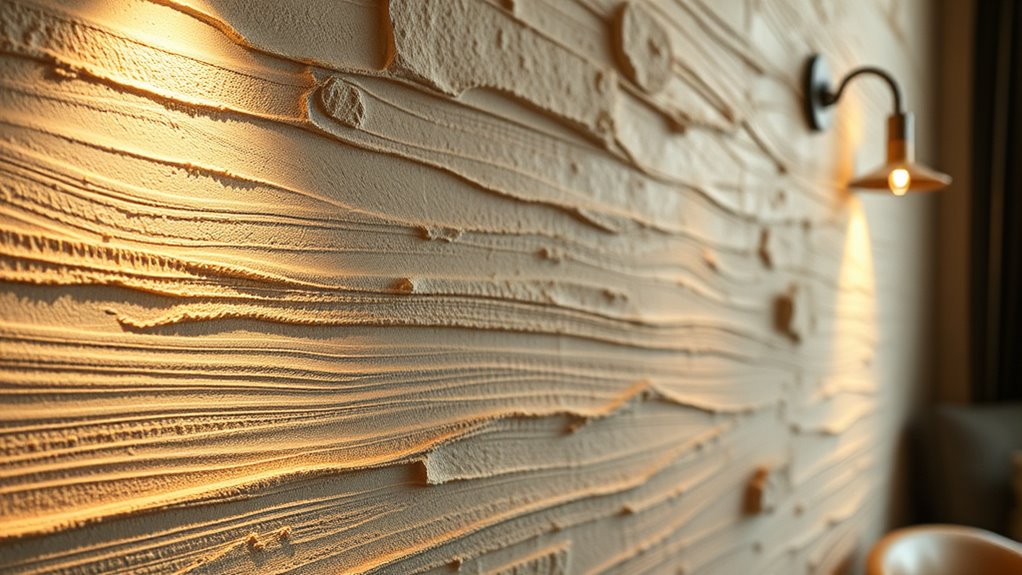
To truly bring out the beauty of your textured walls, effective lighting is essential.
Start with directional lighting, like wall sconces or spotlights, to enhance depth by casting shadows that showcase surface variations. Balance this with ambient lighting, ensuring the overall glow feels warm and inviting.
Enhance the beauty of textured walls with directional lighting, balancing it with warm ambient illumination for a welcoming glow.
Experiment with different light sources, such as LED or incandescent bulbs, to highlight intricate details and patterns. Incorporate dimmable lighting for flexibility in mood, allowing you to adjust intensity and warmth for various occasions while enhancing texture’s visual appeal.
Finally, using a mix of warm and cool lighting can create a dynamic interplay on textured walls, emphasizing their features and maintaining a cohesive design aesthetic. Additionally, consider the impact of durable materials when selecting wall textures, as they can influence how light interacts with the surface.
Maintenance and Care for Textured Surfaces

To keep your textured walls looking great, regular cleaning is essential.
You’ll want to tackle any surface imperfections quickly and protect them from moisture damage.
Regular Cleaning Techniques
Maintaining the beauty of textured walls requires regular cleaning techniques that keep them looking fresh and vibrant. Start by dusting your walls with a microfiber cloth or soft brush to prevent dirt buildup. For deeper cleaning, use a damp sponge with mild soap, but avoid saturating the texture. A vacuum with a brush attachment can help remove dust from intricate designs without abrasion. Spot clean stains promptly with appropriate cleaners tailored to your wall material. Schedule periodic checks to assess your texture’s condition and tackle any wear before it needs extensive repairs.
| Cleaning Method | Frequency | Tools Needed |
|---|---|---|
| Dusting | Weekly | Microfiber cloth/brush |
| Deep Cleaning | Monthly | Damp sponge, mild soap |
| Vacuuming | Bi-weekly | Vacuum with brush attachment |
| Spot Cleaning | As needed | Appropriate cleaner |
| Maintenance Check | Quarterly | Inspection checklist |
Repairing Surface Imperfections
While inspecting your textured surfaces, you’ll want to address any cracks, chips, or discoloration right away. Repairing surface imperfections promptly helps maintain their aesthetic appeal and integrity.
Use a gentle cleaning solution suited for your texture type; a damp cloth works wonders for plaster, while soft brushes are great for woven coverings. For minor repairs on plaster surfaces, mix a small batch of the original plaster material to fill in cracks or holes, matching the existing texture closely.
Don’t forget to dust your textured walls regularly to prevent buildup that can hide their beauty. If needed, consider repainting or reapplying protective finishes as recommended to restore the original sheen and color of your textured surfaces.
Protecting From Moisture Damage
Since textured walls can be vulnerable to moisture damage, it’s important to take proactive steps to protect them.
Regularly inspect your textured surfaces for signs of moisture damage, such as discoloration or peeling, and address these issues promptly.
Consider using non-toxic, moisture-resistant sealants to enhance protection while keeping the wall breathable.
In areas prone to humidity, like bathrooms and kitchens, guarantee proper ventilation to minimize moisture buildup on your textured surfaces.
When cleaning, use a damp cloth instead of excessive water to avoid saturating the material, which can lead to deterioration.
Future Trends in Textured Wall Design
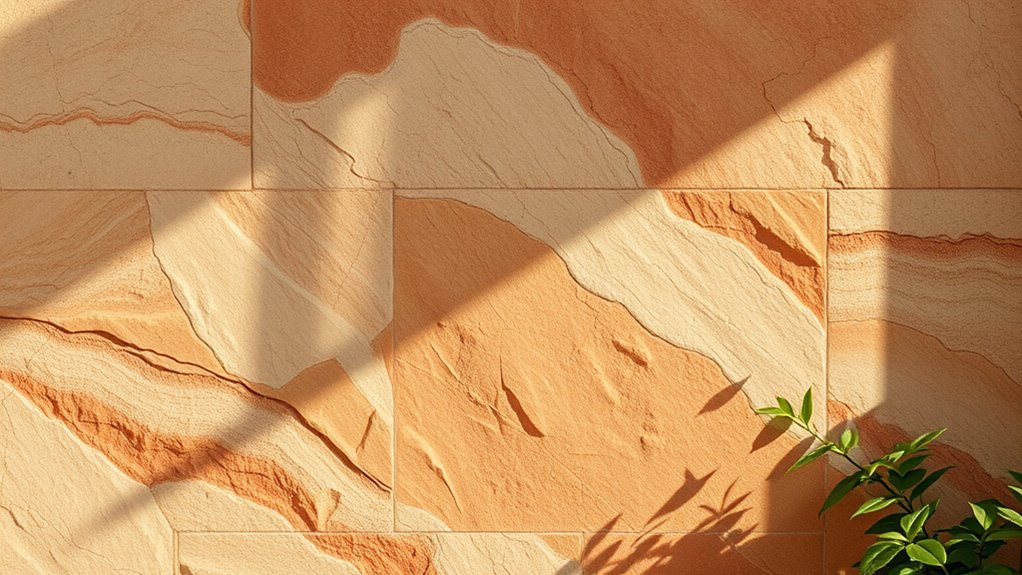
As homeowners increasingly seek warmth and character in their living spaces, the future of textured wall design is set to embrace a blend of sustainability and personalization.
You’ll likely see a rising demand for textured walls featuring materials like reclaimed wood and clay, creating bold statements that reflect your values.
Expect vibrant colors and intricate patterns in plaster and stucco finishes to replace minimalism, allowing you to express your unique style.
Textured ceilings will also gain traction, introducing coffered designs and sculptural elements that draw the eye.
Plus, advances in digital fabrication will enable customizable textures, giving you the freedom to design interactive walls that respond to your environment.
Incorporating senior living considerations into your design choices will further enhance the comfort and accessibility of your space.
Get ready to transform your space into a true reflection of you.
Frequently Asked Questions
What Is the Current Trend for Wall Texture?
The current trend for wall texture focuses on moving away from flat finishes, embracing materials like limewash, plaster, and woven coverings.
You’ll find techniques such as Venetian plaster and intricate carvings gaining popularity for their unique artistic flair.
Dark neutral and warm-toned plasters embody the wabi-sabi philosophy, celebrating natural beauty and age.
This trend isn’t just a moment; it encourages creativity and personalized expressions in your home, promising to thrive through 2025.
How to Make Textured Walls Look Modern?
To make textured walls look modern, focus on neutral or earthy colors that enhance the design without overpowering it.
Pair your walls with sleek, minimalist furniture that complements the textures while keeping the space open.
Use strategic lighting to highlight the textures, creating dynamic shadows and depth.
You can also experiment with subtle geometric patterns or motifs to add visual interest, ensuring everything aligns with contemporary design trends for a cohesive look.
Are Textured Walls Out of Date?
Are textured walls out of date? Not at all! They’re making a stylish comeback.
You’ll find their warmth and character inviting, their unique surfaces enchanting, and their practical benefits undeniable. Instead of being outdated, textured walls embrace modern design, enhancing acoustics and hiding imperfections.
As you create your personalized space, consider incorporating textures that resonate with your style. They’re not just trendy; they’re here to stay, adding depth to your home’s aesthetic.
Why Do People Want Textured Walls?
People want textured walls because they add depth and personality to their spaces.
You’ll find that these surfaces create a warm, inviting atmosphere, making your home feel more cozy.
Textured walls also help hide imperfections, perfect for busy areas, while enhancing acoustics by diffusing sound.
Plus, they encourage sensory engagement, allowing you to connect emotionally with your environment.
Conclusion
So, you thought plain walls were enough? Embracing textured walls might just be the most daring choice you make—after all, who wouldn’t want to turn their living room into a mini art gallery? By mixing and matching textures, you’re not just following a trend; you’re making a statement that says, “I have a flair for the dramatic.” With the right lighting and care, your walls could become the envy of every minimalist around. Go ahead, let your walls do the talking!
